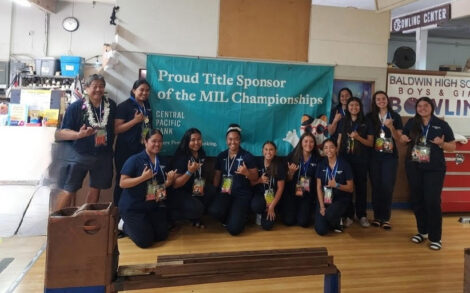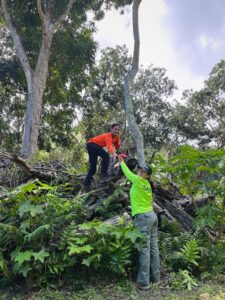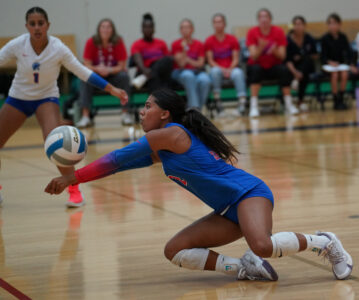Lauhala Weaving: Ancient art in good hands
WAILUKU – From a distance, Pohaku Kaho’ohanohano looks like most any other merchant opening up his shop on Market Street on a sunny October morning. He’s wearing a hat, has some tattoos on his arms and smiles as he waves to someone across the road.
But when you get closer, everything comes into focus, woven into a specific pattern that’s all his own. The stylish hat is made of lauhala, the heartfelt tattoos honor his love for lauhala and the storefront windows overflow with lauhala.
Clearly, this man named for stone has another mission in mind: Reviving the art of lauhala weaving on Maui.
“He has brought lauhala weaving to great prominence here on Maui and has ignited the passion for weaving in so many people,” noted Hokulani Holt, longtime kumu hula and cultural director for Hawai’i Papa o ke Ao at the University of Hawaii Maui College.
The work of Kaho’ohanohano and other weavers can be seen along with the work of masters from long ago in two lauhala exhibits in the Schaefer International Gallery at the Maui Arts & Cultural Center that are on display through Dec. 20.
“All Hawaiians are descended from weavers,” said Kaho’ohanohano during a symposium at the MACC that opened the exhibits. “We got here on canoes with sails made of lauhala.”
Kaho’ohanohano’s resume reads like that of a longtime kumu: studying under seven expert lauhala weavers, teaching for more than 20 years, already the subject of a video about his life. And, yet, he’s only 41 years old. Although more Gen X than kupuna, Kaho’ohanohano was born with an old soul that gave his life meaning.
“I never really liked hanging out with people my own age. They just didn’t know that much,” he said, putting aside the hat he was weaving. “If you want to know the old ways, you learn from the older people. They’re the ones who carry the ancient knowledge.”
When Kaho’ohanohano became interested in the past, he was not thinking that lauhala weaving was his future. He was interested in genealogy. While researching his family tree, he found that the hala towered over everything else.
“Both of my dad’s grandmothers were weavers – and so were their mothers and grandmothers,” he said.
Kaho’ohanohano was unaware of this for many years because the last of his kupuna who was a weaver – Elizabeth Pali – died in 1945. A year later, the devastating tsunami of April 1 washed out the family home in Kahakuloa – and, along with it, all the lauhala treasures his great-grandmothers had made, saved and collected over the years. Generations of weaving and the precious pieces made from the hands of his ohana were gone.
“When I started weaving in 1993, it had been lost in our family for 48 years,” he said.
About that same time, there was also the concern that the art of lauhala weaving on Maui could soon be lost. Nearly all the weavers left were kupuna. Now determined to bring back his family’s legacy, 19-year-old Kaho’ohanohano began seeking out those kumu to teach his fingers how to follow their handiwork. He did not realize he would be keeping alive an important part of Maui history that seemed on the verge of disappearing.
He approached weaver June Ka’aihue of nearby Honokohau Valley about his desire to learn. She told him to “go pick your material, and I’ll show you how to clean and prepare.”
Kaho’ohanohano found a grove of hala, those otherworldly trees with teepees of aerial roots. (The late Emmaline Agpalo, one of his future kumu, called them “the walking trees.”) The young novice carefully collected an armload of dried leaves from the ground and returned to Ka’aihue where he proudly presented them to her. She took one look at his pickings and pronounced them as “junk.”
That did not deter either of them. Kaho’ohanohano still wanted to learn – and Ka’aihue, who lives in the valley to this day, was happy to teach him as were other master weavers. Immersing himself in the art of his great-grandmothers, Kaho’ohanohano would not only spend an hour or two with his kumu, he became part of their lives as he observed how to pick, clean, de-thorn, roll, strip, cut and – finally – weave. An added bonus: five of his seven kumu spoke Hawaiian. So Kaho’ohano-hano not only learned an ancient Hawaiian art from Hawaiian weavers, but he learned in much the same way as his ancestors did.
“It was a more traditional way of learning,” he said. “You kind of became part of their family. We’d talk about the olden days, what it was like when they were younger. I never took notes when they would show me something. You just watched and did it. I think the want to learn made me retain more.”
The want to learn kept growing. Two decades later, he shares a shop, Hale Ho’olana, with his wife, Ki’i, a lomi lomi practitioner, and other therapists who work in another part of the building. The shelves of his store – part retail/part museum – are stocked with the many fruits of his labors – everything from the first item he finished (a basket) and his earliest bracelets to intricate mats and fine hats, which are always in demand. Hats, he says, are “my canvas.” There are no two alike.
Kaho’ohanohano seems to have the ideal personality for weaving. Even at the top of his craft, he remains humble, patient and kind, something he obviously learned from his kumu.
“He has brought great honor to his teachers and has become a source for his own students,” observed Holt. “This is how it should be in a Hawaiian cultural practice.”
Kaho’ohanohano prefers weaving with company rather than alone.
“I work better with other weavers around me,” he said. “We talk and time takes over and flows well. You need discipline for this. If you’re by yourself, you need to make yourself sit down and get it done. When you’re weaving with other people, you just feel it. It’s like social hour.”
As Kaho’ohalahala began his life of weaving with his kumu, he also absorbed the history of lauhala and its place among his Hawaiian ancestors. In earlier times, so much of everyday life revolved around lauhala: thatching for shelters, floor mats, sleeping mats, pillows, baskets, burial mats, even the magnificent sails that brought the first Polynesians here.
“Nearly every Hawaiian girl would have learned weaving in those days,” said Kaho’o-hanohano. “So much was handmade.”
Families often had their own patterns of weaving that they guarded like secrets. Skilled weavers today can look at a piece of lauhala and, simply by eyeballing the style or a specific characteristic, can identify the island where it was woven or even the family that produced it.
The gentle nature of lauhala weaving, the communal aspects and almost meditative state one can reach while repetitiously plaiting the strips of leaves has other benefits.
“It’s therapeutic,” said Kaho’ohanohano. “One of the reasons weavers live a long life is that there’s no stress in this.”
Lately, however, a stress factor has emerged for weavers in the form of a scale that’s threatening to overtake the groves of hala and render the leaves unusable. The pest was first discovered in East Maui and has now crept across Maui and even to Molokai. Kaho’ohanohano said his frequent trips to gather leaves in Hana have all but ended. He still knows where healthy trees exist – and is growing his own stand to supply him with materials.
Lauhala weaving has changed in another significant way for Kaho’ohanohano. Most of the kupuna who shared their invaluable knowledge – and infectious personalities – have now died, leaving empty spaces in the weaving circles. The shelves of his store hold their photographs and, too often, their funeral programs. It makes for a noticeable difference in the social hour.
“When I first started, it was mostly kupuna weavers, now hardly any kupuna weavers,” he said with a sigh. “Now mostly newer weavers.”
But a new wave of weavers means there’s a future for this ancient art that must have those kupuna smiling from above. Among that new wave is another Kaho’ohanohano: 8-year-old Leihala.
“She’s woven a few bracelets,” said the proud dad.
The family tradition – and a revived tradition on Maui – appears to be in good hands.
* Valerie Monson is a former Maui News staff writer.



